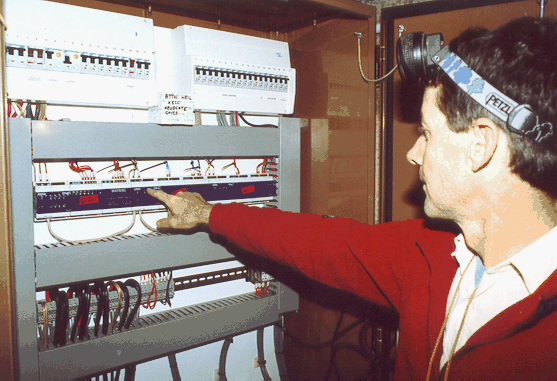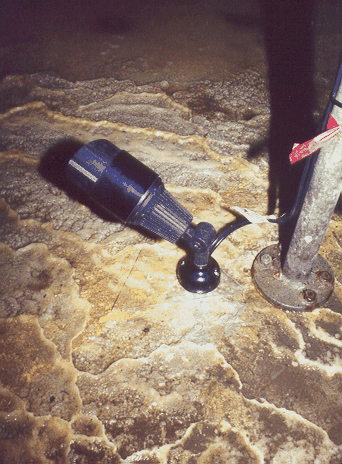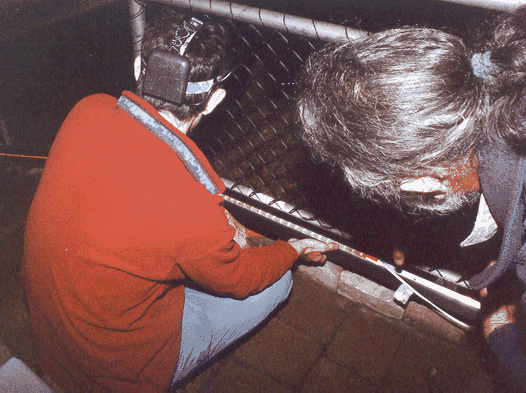Newdegate Cave is the jewel of Hastings Caves and Thermal Springs tourist destination in the far south of Tasmania. It was officially opened in 1939 following the installation of a new 110 volt lighting system, and in the following decades Hastings Caves became one of Tasmania's major tourist attractions.
Over time the lighting system in Newdegate Cave has undergone renovation, but by the 1990s the lighting itself was showing itself to be a poor performer in presenting the magnificence of the cave to the visitors, while environmental problems resulting from the use of the lighting were becoming apparent. Comment about the serious degradation of the cave by decades of visitor operations gave rise to a rehabilitation programme with the aim to reverse the decline.
One component of this programme was the design and installation of a new lighting system for the cave, chiefly aimed at reducing the lighting levels to control lampenflora, better lighting of pathways for safety, minimising maintenance impacts, creating energy savings through efficient lighting design and technology use, enhancing the aesthetic presentation of an unique environment.
In-cave works projects are singularly unusual, having little in common with our dealings with the "built" environment.
The project for relighting Newdegate Cave gave rise to one range of solutions for the problems identified in advance and discovered along the way. In as much it becomes an experiment to test ideas, techniques, and technologies. What follows is a rough guide to what happened, and why.
April 2000. Received a phone call from Ian Houshold asking if I would be interested in relighting Newdegate Cave. The easiest answer was to say yes, what I did not then consider were the implications down the track. A week was spent on site in May to discuss and assess various options with management and operational staff.
My proposal was that an entirely new system could be installed within the confines of the existing impacted pathway zones without impinging on the existing lighting system, enabling work to proceed without disruption to the daily guiding operations.
Proposed new handrails were noted to be modified, to enable retrofitting of linear pathway lighting. Budget proposals were reviewed (upwards). No decisions were taken on the type of electrical system and the form of lighting, but lingering in the back of my mind was the brief discussion I had with Elery Hamilton Smith in the cave during the 1995 ACKMA conference visit, about a vision of relighting the magnificent Newdegate Cave.
July 2001. This time, Mark Bryce (Southern District Manager, Parks and Wildlife Service) telephoned to suggest that the relighting was ready to roll. I ticked up my leave card and booked into Hastings for all of August. The new stainless steel handrails were now in place with no modification to accept any pathway lighting. The first two weeks were totally committed to in-cave lighting design and designing pathway lighting to graft onto the handrail structure, to produce a lighting plan which did not compromise the "no access" cave floor zones determined with Ian Houshold.
 |  |  |
| Neil Kell points out the new computer lighting system in Newdegate Cave | Light fitting in Newdegate Cave | Neil Kell adjusts the track lighting while Arthur Clarke looks on |
It was apparent the cave tours needed three lighting use options, single guided tour in-cave, up to five guided tours in-cave, and a concert event, and that this could be accommodated with a Clipsal C-Bus Minder system.
There was now the basis on which to build a works project. Activity ramped up, Peter Bell was brought on site for 4 days of c-bus planning, suppliers were tracked down, ordering commenced.
The implications now appeared. Mark Bryce asked if I would run the total project to completion ...arrrrrgH!!! I skipped the following nights' sleep and said yes, resigned from my hardware job and rearranged the next few months of life. Oh well, a taste of life in southern Tassie is bound to be positive.
I was back in October 2001 with a project plan for completion by Christmas. With the assistance of Hastings' guides Roger Griffiths, Peter Price, and Jason Gardner as the "workers" the in-cave project got under way working evening shifts Monday to Thursday, and a day shift on Friday.
There were trials, rethinks, and delays, along the way, but no major problems except that we found that the dolomite is very resistant to rock breaking. Electrical 240 volt supply cables and 12 volt lighting cables were laid along the pathway zone and under paved areas, light fittings were assembled and placed into position and connected to cables. A major component of the electrical infrastructure (the four switchboards) was contract built in Hobart and fitted out for all the c-bus, 240 to 12 volt transformers, and plug-and-play lighting circuit connections before being transported into the cave.
This alone saved weeks of electrical contractor time against doing all the work in-cave. The linear pathway lighting components were assembled at the Hastings workshop, and sections of both straight and curved pathway curbing was built to carry pathway lighting where there was no handrail support.
Development of lighting scenarios for the c-bus operation proceeded thanks to the considerable support from Peter Bell. Three scripts needed to be developed to run individual, multiple, and concert, cave tour lighting programmes. By late November it was apparent that we would be tempting risks by aiming to squeeze in completing the project before Christmas. We ceased work mid December and left the staff and cave to carry the load of the busy summer holiday season.
Early February brought the work back to life for a headlong run to finish in three weeks. All the plug and play components of C-bus, pathway lighting, transformers, were fitted into place ready for the final Minder software install and trial run. And as always, there are many small tasks found awaiting completion in these final stages. But as some of the caves staff can testify the last week became a blur of activity as the official opening by David Llewellyn, Minister for Primary Industries, Water and Environment, became a reality.
Peter Bell returned for the c-bus commissioning, and with the programmer from Hobart we discovered a glitch in the best of plans. Three days of frenetic ponderings and 'round the clock' script revisions brought the new lighting into operation on opening day ... just!!
Newdegate Cave now had a new lighting experience for both guides and visitors. It is probably not an understatement to say that guides had little idea of the changes they faced in moving from conducting tours in the morning with the old lighting, to returning to the cave in the afternoon with the new lighting. Over two days and with on tour prompting the transition was being accommodated, guides can change and adapt.
Some programming problems were identified and modifications made, but overall it is intended to run the current lighting programmes for six months then conduct a review, to identify the changes required. Also planned in the coming financial year is the installation of an 'uninterruptable power supply' unit to power the pathway lighting in cases of mains power failure, and the removal of the old lighting system.
By now one might well ask ... "ok, what is the new lighting like?" If I may use the words of some Hastings guides, it is simply a new cave to experience. To enable me to craft such a change, I can only say that my inner view was affirmed by hearing Ian Houshold comment that he considered the old lighting effect made the cave feel like a brown barn full of light, lacking the darkness appreciation that should naturally be self evident on visiting the cave. Having that clear statement, and being given free reign to "create" definitely made the task easier.
The lighting design process that followed was based on the principles of lighting for access and atmosphere, developing a system of linear lighting to directly illuminate pathway surfaces, which then enabled creative use of 12volt dichroic feature lighting to generate the various lighting effects for atmosphere.
One of the challenges of relighting Newdegate Cave with greatly reduced lighting is that one needed to be very discretionary as to what to light, and what not to light, basing my premise on the fact that deploying any light in a darkened environment would create a dramatic effect. As the cave had many interesting and dramatic features, there was really never a problem finding a focus to light, but there was some difficulty in deciding on what to not light, and achieving the balance of meaning across the field of view from light to darkness.
Due to the fragility of much of the surface structures in the cave, large areas were considered "no go" for access to place lighting infrastructure, thus ruling out many lighting opportunities. On top of that I added constraints that the majority of light fittings were to be placed within arms reach of paved or hardened surfaces, and that no new fixing holes were to be drilled into cave surfaces.
There is another principle of cave lighting that I considered important enough to cause a rethink of how to relight the cave. This is the consideration of the whole cave tour as a "performance" with a structure that might be found in an orchestral performance with its overture, movements, finale, and coda.
A little analysis of a Newdegate tour revealed that of the 45 minute in-cave tour 35 minutes was committed to touring through to the rear of the cave, and 9 minutes to retrace the pathway to return to the surface. This is often referred to as the "bolt and run syndrome". To create a more balanced tour structure the existing visual finale of the Titanias Palace at the rear of the cave was de-emphasised, being relaced with a completely new spatial finale just before exiting the cave. The result is a faster tour into the cave and therefore more time to allow for the return journey and re-viewing the cave under different lighting arrangements. It is in this finale that the magnificent space of Newdegate Cave is more fully revealed in layers of light before slowly sliding back into darkness.
Enough on lighting for "atmosphere", I would like to return briefly to pick up on lighting for "access". Access lighting is easily considered just on its practical merits, and rightly so, but I can see no reason why it should not perform in the context of enhancing the lighting for atmosphere. With such consideration access lighting can indeed be designed to create a vision of safe access through a wilderness of darkness, a zone of familiarity within an environment that is largely unfamiliar to the majority of cave visitors.
The end result in Newdegate Cave is a significant advance on any cave access lighting I have viewed to date, to the point where I dare to state that access lighting should take planning precedence over all other lighting to "get it right", for without lighting for access you cannot go far at all.
It must be said that tapping into the potential of C-bus Minder for lighting control made the early stages of lighting design proceed quickly because I could envisage how the various lighting scenes would come together. However considerable time was eventually committed later on into scripting some 45 circuits into a safe, engaging, and meaningful use of light to support a "tour", and in this case it was done to create three tour scenarios.
The idea that good cave lighting is 10% inspiration and 90% perspiration needs to be revised to allow for much more needed inspiration (more like 40%). With some understanding of the capabilities of c-bus and the hard-wired cave circuits, anyone with the necessary inspiration can craft a script to relight the cave. To not realise this potential would be a waste of the value of the system to the operation of the cave for visitor experiences into the future.
So what might the Newdegate Cave visitor experience with the new lighting?
To be honest I am tired of my clumsy efforts expended in writing this, so it is probably wiser for me to suggest that you go see for yourself, a viewing is worth more than any number of words that I might cobble together here. The guides at Hastings are enthusiastic about their cave and are impressed by the dramatic difference that can be achieved by a bit of twiddling with light. I will be content to be excited with prospects of exercising my design skills, visual aptitude, and cave experience, plus some troglo-inspiration on another tourist cave!